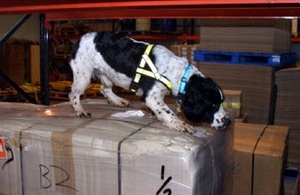It is a real pleasure to be able to address this year’s virtual Oxford Farming Conference – obviously the 75th such conference so an important milestone. The new national lockdown restrictions, which have been announced in recent days are a reminder that we are far from out of the woods as we fight the coronavirus pandemic.
Our key workers in the NHS will be tested in the coming weeks. And those key workers in the food supply chain, working on farms, in food factories, in the distribution chain and in supermarkets will again be performing a vital function to ensure that the nation is fed while others stay at home.
The events of the last year have highlighted the importance of domestic food production to our food security and testing times such as these are a reminder to society about the jobs which really are important.
There is a key difference between this current lockdown and the first one. Technology has emerged with a solution. This week the AstraZeneca vaccine developed in Oxford has started to be deployed. The development and rapid authorisation of both the Pfizer and now AstraZeneca vaccine has been an incredible feat of science. And this is an area where the UK has global leadership.
And it is science that I want to focus on today because the UK is home to some of the world’s leading agricultural research institutes.
We have the John Innes Centre in Norwich with its focus on agricultural technology, the work of the National Institute of Agricultural Botany with its work on sustainable agronomy and climate resilient crops, the James Hutton Institute in Scotland with its pioneering work on vertical farming and sustainable land use.
Then there is the ground-breaking work done at Aberystwyth on grassland management and livestock, the work of the Rothamsted Research on genetic technology and of Cranfield University’s work on soils… to mention but a few.
The expertise that we have here in the UK is of global importance and we are global leaders in many areas of research.
Take wheat – it is not only the world’s oldest major agricultural crop, it is also the most widely grown, it is Britain’s largest crop, and it supplies a fifth of all human calories worldwide. But it is also affected by climate change.
UK funded research is leading efforts to address that threat, including UKRI’s Designing Future Wheat initiative and Defra’s Genetic Improvement Networks.
I have said previously on many occasions, that, as we consider future policy, what we really need to achieve is a fusion of the traditional principles of good farm husbandry with the best technology available to us in the 21st century.
The intensification of agriculture during the 1960s and 1970s led to higher yields, brought more land into cultivation and delivered the post war imperative to boost food production.
However, it also led to a sharp increase in the use of synthetic fertilisers which, in turn increased carbon emissions; it led to the loss of thousands of miles of hedgerows which are the single most important ecological building block in our farmed landscape; it led to the ploughing up of traditional meadows and the loss of the ecology contained within them; it led to an increase in the use of synthetic pesticides which had impacts on non-target insect species too; latterly it led to greater specialisation on farms leading to more pressure on water quality in livestock areas and the unsustainable exploitation of soils in arable areas.
We now know that the impacts of these changes caused a sharp decline in farmland bird populations and other measures of biodiversity. The pace of decline has certainly slowed in recent years as protections were increased and policy started to refocus, but reversing the trends has proved stubbornly difficult to achieve.
But imagine if we could retrace our steps back to the late 1960s and plot a different course, the benefit of hindsight. What might it look like and what might we do?
Perhaps we would have placed more value on the traditional meadows and the hedgerows and rewarded farmers for managing them well.
Perhaps we would have encouraged more sustainable management of soils with more emphasis on mixed systems and less on specialisation; perhaps we would have supported more extensive systems of farming that relied on fewer external inputs.
And if it were available to us then, perhaps we would have seen the potential to reconcile sustainable farming with vibrant and profitable food production through the deployment of genetic resources.
Genetic diversity is what gives life itself resilience. The billions of genes that exist in the millions of plant and animal species on our planet are a memory of all the challenges that have been encountered in the past and can help us prepare for the challenges of the future.
There are genes that cause wild grasses to search deeper in soils for their nutrients, there are genes that give plants natural resistance to fungal diseases, there are genes that enable plants to synthesise natural hormones that deter certain insect pests and genes that enable plants to cope better with water stress. What we have now that we did not have in the 1960s, is the ability to harness the genetic resources that mother nature has provided to tackle the challenges of our age and to replace some of the harmful practices that led to environmental harm in the past.
Twenty years ago, there was much debate about genetically modified crops. It is fair to say that there was understandable public concern about moving genes across natural biological boundaries – or transgenesis.
In particular, it will always be important to have a robust and precautionary regulatory system in place to govern genetic modification when transgenesis is involved.
Nature has created natural processes to buffer the movement of genes across biological boundaries through the compatibility of flowers from different plant species. Even when methods like grafting or budding are deployed, biological compatibility between the rootstock and the scion really matters.
However, what we have learned since that initial GM debate is that cisgenesis – where traits are moved within a species or genus of plant – is also powerful, but raises far fewer ethical or biological concerns.
Techniques such as gene editing are really a natural evolution of conventional approaches to plant breeding. For some seventy years, plant breeders have used chemical and radiation treatments to generate random mutations in genes in the hope that these might provide traits that are useful for plant breeding. For decades, we have had F1 hybrid breeding techniques that were designed to create far greater genetic consistency in plant varieties grown commercially.
What we are now able to do through techniques such as gene editing is to more accurately move traits within the same species in a way that could happen naturally and which therefore respects the rules of nature.
It gives us the power to evolve plant varieties with particular traits far faster than was ever possible with conventional breeding and this opens up huge opportunities to change our approach and embrace sustainable farming.
It creates the potential to breed plant varieties that have natural resistance to fungal diseases and to evolve traits at a pace that keeps up with the evolving pest.
It creates the ability to breed crops and grasses that perform better with fewer inputs reducing costs to farmers and reducing impacts on the environment, and it creates the ability to breed plants that can adapt to the challenges of climate change.
Water scarcity will be a major impact of climate change and it will mean that land in some parts of the world that can currently be farmed will become unviable in the future unless plant breeding technology is able to keep pace with the challenge.
Two years ago, the European Court of Justice ruled that cisgenic techniques using gene editing should be treated the same as genetic modification under EU law.
That means that new technology would be stifled from the beginning because the EU’s procedures around gene editing are notoriously restrictive and politicised such that no one trusts the integrity of the process. The ECJ judgement was based on legal interpretation, not based on science. The UK opposed the judgement. Even countries like Germany with more scepticism about GM, recognised that gene editing was very different and an important new technology to meet the challenges of the future.
As an EU member, we obviously had no choice but to slavishly adopt the judgements of the ECJ, however irrational and flawed they might be.
Now that we have left the EU, we are free to make coherent policy decisions based on science and evidence and it starts today with a new consultation on proposed changes to English law that will enable gene editing to take place, so that we can achieve a simpler, scientifically credible regulatory framework to govern important new technologies.
If we are to deliver the ambitions we have for the environment and make space for nature, then we must rebalance the incentives in our future agriculture policy to encourage sustainability, but we must also use the tools that science provides to ensure that profitable food production and sustainable land management go hand in hand.


